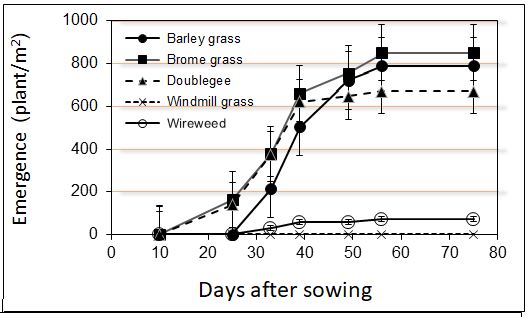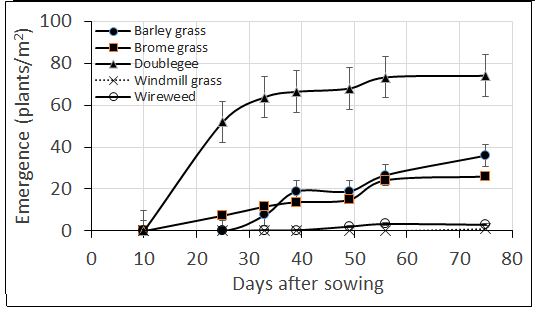Barley grass (Hordeum leporinum) has evolved a delayed emergence strategy to escape knockdowns in Western Australia
Author: Abul Hashem and Catherine Borger (Department of Primary Industries and Regional Development, Northam). | Date: 25 Feb 2019
Key messages
Delayed emergence was found in barley grass populations sourced from WA. Delayed emergence will enable it to emerge after pre-sowing non-selective herbicide application.
Other weed species such as great brome (Bromus diandrus), doublegee (Rumex hypogaes), sowthistle (Sonchus oleraceus) and wireweed (Polygonum aviculare) did not show any unusual delay in emergence.
Aims
Changes in farming systems, farm management practices and climate have allowed some weed species (e.g. barley grass) to become more prominent weeds of cereal crops (Llewellyn et al 2016). To manage these emerging weeds, growers of Western Australia (WA) need information on their ecology, biology, seedbank behaviour and dormancy. At present, information on weed seedbank biology with recent changes to farming systems is not available in WA for weed species including barley grass. Peltzer and Matson (2002) reported that barley grass seed showed no protracted dormancy in 1999 with most seedlings emerging prior to crop sowing being more easily controlled with pre-sowing herbicides. Early experience indicated that this species was unlikely to be problematic in crops due to a lack of long-term seed dormancy, resulting in the majority of seeds germinating with early autumn rains (Popay, 1981). Some information on seedbank biology was generated in the eastern states (Fleet and Gill 2012), or prior to the intensification of cropping, reduction in grazing and adoption of no-till systems in WA. It is likely that the behaviour of weed species would have changed considerably over the last 20-30 years (Hashem and Borger 2018).To manage these emerging weeds effectively, growers are seeking information on their behaviour, especially seed bank persistence.
A nationally coordinated GRDC project (UA00156) is investigating the seedbank behaviour of emerging weed species (great brome barley grass, doublegee, sowthistle, and wireweed in WA) and decline of the weed seedbank under no-till systems. A four-year trial (2016-2019) aimed to determine the seedbank longevity (persistence) and emergence patterns of these five species in a no-tillage cropping system in WA.
Method
Emergence in 2016, 2017 and 2018.
Seeds of barley grass, great brome, doublegee, windmill grass and wireweed were harvested in the spring/summer of 2015/2016, with each species harvested from a no-till cropping field and the adjoining roadside (i.e. two populations per species). In 2016, a site was selected on the deep yellow sand at the Wongan Hills Research Station, Department of Primary Industries and Regional Development (DPIRD). Existing weeds were controlled by applying non-selective herbicide (Roundup® PowerMAX® 1.5L/ha + 2,4-D ester 500mL/ha + Garlon® 60mL/ha) on 8 February 2016, cultivation (autumn tickle) on 7 April 2016, non-selective herbicide (Roundup® PowerMAX® 2L/ha + Hammer® 25mL/ha) on 14 April 2016 and a second cultivation on 9 May 2016. Seeds of each weed population were spread at a density of 1000 seeds within micro-plots of 1m2. Each micro-plot was within a unit plot of 5m x 2m, arranged in a randomised complete block design with four replications, with 4m buffer between replications. Directly after spreading weed seeds, ClearfieldTM wheat was sown at 80kg/ha on 26 May in 2016, 25 May in 2017 and 29 May 2018, using knifepoints and press wheels, with 22cm row spacing. MacroPro Plus® fertiliser (10.0, 14.1, 8.4, 7.9, 0.10, 0.20 NPKSCuZnkg/ha)) at 80kg/ha was banded below the seed, with 50kg/ha of additional N (Flexi N) applied at the tillering stage of wheat. Intervix® (750mL/ha) was applied at the tillering stage of wheat to control wild radish and annual ryegrass.
In 2018, a second micro-plot of 1m2 (containing 1000 seeds) was established in each plot of 2m by 5m, about 50cm away from the original 1m2 plot established in 2016. Seeds of barley grass, great brome, doublegee, and wireweed was sown immediately before sowing the crop, as for 2016. Seed of windmill grass was introduced immediately after sowing the crop.
Weed seedlings were counted and removed after each rainfall event, from the first micro-plot in 2016 and 2017, and from the first and second micro-plots separately in 2018. Since all weeds were counted and removed at the seedling stage, crop growth and yield were uniform and were not assessed. Summer weeds were killed with non-selective herbicide where necessary. The target weed species did not emerge after summer rainfall events. Weather data was collected each year from Wongan Hills (weather station 008137) (Table 1).
Table 1: Monthly mean rainfall in 2016, 2017 and 2018 relative to the long-term average (1907 to 2017) for Wongan Hills (weather station 008137).
| Year | Jan | Feb | Mar | Apr | May | Jun | Jul | Aug | Sep | Oct | Nov | Dec |
|---|---|---|---|---|---|---|---|---|---|---|---|---|
| 2016 | 91 | 0 | 93 | 56 | 42 | 64 | 69 | 51 | 25 | 15 | 2 | 6 |
| 2017 | 63 | 49 | 21 | 21 | 20 | 13 | 47 | 65 | 38 | 18 | 2 | 7 |
| 2018 | 15 | 15 | 19 | 22 | 47 | 62 | 63 | 48 | 28 | 19 | 13 | 10 |
| Long-term average | 15 | 16 | 21 | 23 | 52 | 70 | 69 | 52 | 30 | 20 | 12 | 10 |
Design and analysis
The trial was laid out in a randomised complete block design with four replications. Data on weed emergence were tested using ANOVA.
Results
First trial - Seedling emergence in 2016, 2017 and 2018
In 2016, great brome and doublegee started emergence within seven days after sowing (DAS) the wheat crop and continued up to 95 DAS (with both species producing 9 cohorts of seedlings). However, most seedling emergence of these two species occurred within 7 to 50 DAS (Figure 1, left). By comparison, barley grass showed very slow seedling recruitment (first emergence recorded about 28 DAS, about three weeks after first emergence of great brome). In 2017, there was a dry start to the season (Table 1). The crop was sown into moisture at depth, but the dry top soil ensured that all weeds had delayed emergence. Barley grass seed that had remained dormant in the field in 2016 emerged at the same time as great brome and doublegee (Figure 1, right). Seedling emergence of wireweed was relatively low (<50 plants/m2), but also delayed by about 50 days. Windmill grass did not emerge in either year. For all species, there was no difference between the two populations (seed from cropped fields vs uncropped roadsides) in emergence patterns.

In 2018, all weed species of 2016 residual seed bank except wireweed and windmill grass emerged, in seven cohorts over 75 days after sowing the wheat crop (Figure 2, bottom). No difference in the emergence time of barley grass and great brome was found. Doublegee had the highest cumulative emergence during 2018 season (Figure 2, bottom).
Second trial – Seedling emergence in 2018
Emergence of the weed species introduced in 2018 to a new 1m2 quadrat showed that great brome and barley grass had the highest emergence (800-850 plants/m2). Doublegee had much higher (670 plants/m2) emergence from the 2018 seedbank (Figure 2, top) compared to 2018 emergence from 2016 residual seedbank (Figure 2,bottom).
Despite storing for two years under room temperature, the emergence of barley grass seed introduced in 2018 was again delayed by eight days compared to the great brome seed (Figure 2, top).
Figure 2. Cumulative seedling emergence of five weed species in a wheat crop, recorded after each rainfall event during 2018 season from the seed bank introduced in 2018 (top) and 2016 (bottom) at Wongan Hills, Western Australia. Vertical bars indicate the standard error of four replications.
Conclusion
Delayed emergence of barley grass recorded in this trial will complicate the control of barley grass. Barley grass is known to have a vernalisation requirement to overcome seed dormancy (Fleet and Gill 2012).The delay in the emergence of barley grass relative to the crop suggests that some WA populations of barley grass may have developed increased seed dormancy similar to that noted in South Australian populations (Fleet et al 2012, Gill et al 2013, Cook 2017). Barley grass seed showed no protracted dormancy in 1999 (Peltzer and Matson, 2002) with most seedlings emerging prior to crop sowing being more easily controlled with pre-sowing herbicides. Dormancy of barley grass in WA may have increased as for the South Australian populations, possibly in response to increased cropping intensity. Increased seed dormancy in barley grass would allow it to evade early season weed control tactics, making selective control more difficult.
Borger and Hashem (2018) showed that late germinations of barley grass were less competitive with the crop (i.e. had little impact on yield) and produced few seeds. However, they had a short growth habit and greater potential to escape harvest weed seed control (HWSC). The current research also highlights the longevity of the seedbank, and demonstrates that at least three years of control is required to exhaust the seedbank.
References
Cheam AK and Lee S (2009) Inversion ploughing: Effects of long-term deep burial on weed seed reserves. Proceedings of Agribusiness Crop Update. Available at https://www.agric.wa.gov.au/sites/gateway/files/Inversion%20ploughing%20Effects%20of%20long%20term%20deep%20burial%20on%20weed%20seed%20reserves.pdf.
Cook A (2017) Options for managing barley grass in crop. Available at https://grdc.com.au/resources-and-publications/grdc-update-papers/tab-content/grdc-update-papers/2017/08/options-for-managing-barley-grass-in-crop.
Fleet B and Gill G (2012) Seed Dormancy and Seedling Recruitment in Smooth Barley (Hordeum murinum ssp. glaucum) Populations in SouthernAustralia. Weed Science 60(3):394-400. 2012
https://doi.org/10.1614/WS-D-11-00203.1
Gill G (2007) GRDC Final reports of UA000060 – Developing management systems for great brome, a serious threat to production systems on fragile sandy textured soils in South Australia, University of Adelaide, South Australia. Available at https://grdc.com.au/research/reports/report?id=540.
Hashem A, Borger C (2019) Emergence pattern and seedbank decline of emerging weeds in the field. Proceedings of GRDC Research Update, Perth. Available at http://www.giwa.org.au/2018researchupdates.
Heap I (2019) International survey of herbicide-resistant weeds. http://www.weedscience.org/Summary/Species.aspx.
Llewellyn RS, Ronning D, Ouzman J, Walker, Mayfield A and Clarke M. 2016. Impact of Weeds on Australian Grain Production: the cost of weeds to Australian grain growers and the adoption of weed management and tillage practices Report for GRDC. CSIRO, Australia. GRDC, PO Box 5367, Kingston ACT 2604. Available at https://grdc.com.au/data/assets/pdf_file/0027/75843/grdc_weeds_review_r8.pdf.pdf. Accessed on November 11, 2017.
Peltzer SC and Matson PT (2002) How fast do the seedbanks of five annual cropping weeds deplete in the absence of weed seed input? In HS Jacob, J Dodd and JH Moore (eds.) proceedings of the 13th Australian Weeds Conference. 8 -13 September, Perth. pp 553-555.
Popay AI (1981). Germination of seeds of five annual species of barley grass. Journal of Applied Ecology 18, 547-558.
Acknowledgments
The research undertaken as part of this ‘Emerging weeds –seedbank biology’ project (UA00156) is made possible by the significant contributions of growers through both trial cooperation and the support of the GRDC; the authors would like to thank them for their continued support. We are thankful to all the staff at the Wongan Hills Research Station of Department of Primary Industries and Regional Development (DPIRD), Nerys Wilkins, Pete Gray, Cameron Wild, Dave Nicholson, and Barbara Sage, for all the technical assistance in conducting the trial. We are also thankful to Dr Gurjeet Gill, University of Adelaide for research collaboration.
Paper reviewed by: Dr Sally Peltzer and Dr Jason Emms.
GRDC Project Code: UA00156,
Was this page helpful?
YOUR FEEDBACK


